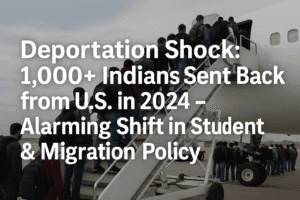Deportation Shock: 1,000+ Indians Sent Back from U.S. in 2024 – Alarming Shift in Student & Migration Policy
India confirms over 1,000 nationals have returned or been deported from the US since January, highlighting a significant enforcement shift. This surge, linked to former President Trump’s intensified campaign against undocumented migration, includes alarming tactics like military flights and shackling. With an estimated 18,000 Indians potentially undocumented, recent US warnings threaten permanent bans even for legal overstayers, creating widespread fear.
Simultaneously, new US visa policies—halting student interviews for expanded social media screening—cause deep anxiety for India’s massive student population, the largest in the US. The parallel move to aggressively revoke Chinese student visas underscores a broader climate of restriction. These developments represent not just policy changes but profound human costs: shattered dreams, family separations, and a chilling effect on education and migration.
The situation tests crucial US-India cooperation on migration while signaling a potential decline in America’s appeal as a destination for Indian talent and students. This marks a pivotal moment impacting lives and bilateral relations.

Deportation Shock: 1,000+ Indians Sent Back from U.S. in 2024 – Alarming Shift in Student & Migration Policy
The recent announcement by India’s foreign ministry that over 1,000 Indian nationals have “come back or [been] deported” from the United States since January isn’t just a statistic. It’s a tangible manifestation of shifting US immigration priorities under the looming shadow of an election year and a potential second Trump term, impacting lives and futures on both sides of the globe.
The Deportation Reality:
- Scale & Method: While India’s Foreign Ministry spokesperson Randhir Jaiswal confirmed the figure, the breakdown is telling. Approximately 62% returned via commercial flights, implying potential voluntary departures or standard removals. However, the remaining 38% likely involved more direct enforcement actions.
- Military Flights & Tactics: The stark image of over a hundred Indians deported on a US military flight in February, some reportedly shackled, underscores a hardening approach. This method, typically reserved for larger groups or individuals deemed higher risk, signals an escalation in operational intensity.
- The Larger Shadow: Crucially, these 1,000+ individuals represent only a fraction. US authorities estimate roughly 18,000 Indian nationals are currently in the country illegally. The recent US Embassy warning in India – explicitly stating overstaying can lead to deportation or a permanent entry ban, even for initial legal entrants – amplifies the pressure.
The Trump Effect & Bilateral Dynamics:
- Policy Catalyst: This surge aligns directly with former President Donald Trump’s renewed, vigorous campaign rhetoric targeting undocumented migration. His public statement that India “will do what’s right” on deportations frames this as a bilateral expectation, not merely unilateral US action.
- Cooperation & Verification: Jaiswal’s assertion of “close cooperation” and India’s verification of nationality before accepting returnees highlights a necessary, albeit complex, diplomatic and logistical process. This cooperation is crucial but operates under significant strain due to the scale and political sensitivity involved.
The Student Visa Chill: A Separate but Related Anxiety
Beyond deportations, a profound unease grips Indian students – the largest cohort of international students in the US (330,000 in 2023-24).
- Policy Shifts: The US State Department’s abrupt halt on scheduling new student visa interviews, citing expanded social media screening protocols, creates immediate uncertainty.
- India’s Concern: While acknowledging visa issuance as a “sovereign function,” India’s public plea for applications to be judged “on merit” to avoid academic disruption reveals deep apprehension. Delays or denials based on vague social media criteria could derail countless educational journeys and career plans.
- The China Parallel: The simultaneous US announcement of “aggressively revok[ing] visas for Chinese students” linked to the CCP or in critical fields underscores a broader trend of heightened scrutiny on foreign students, particularly from strategic competitor nations. Indian students, while not targeted in the same geopolitical terms, navigate this increasingly restrictive environment.
The Human Impact & Shifting Landscape:
- Lives in Limbo: For those deported, the consequences are devastating – separated families, shattered American dreams, and the stigma of return. For students in limbo, it’s anxiety, potential lost deposits, and delayed futures.
- Deterrence & Choice: The aggressive deportation message and student visa hurdles act as a powerful deterrent. Potential migrants may reconsider irregular routes, while future students might increasingly explore alternatives to the US (Canada, UK, Australia, Europe, or even India’s own growing universities).
- Bilateral Relations: Migration remains a critical, yet potentially contentious, pillar of US-India relations. How both governments manage the pressures of enforcement, due process, and the legitimate aspirations of students and workers will significantly impact the broader partnership.
Beyond the Numbers:
The figure “over 1,000” is a snapshot of a dynamic and often painful process. It reflects:
- An Escalation: Increased operational tempo in US immigration enforcement.
- A Political Imperative: Trump’s campaign promises translating into tangible action.
- Deepening Anxiety: Among the Indian diaspora without status and among the vast student community.
- A Test for Cooperation: Requiring careful navigation between US enforcement goals and India’s responsibility to its citizens.
- A Potential Inflection Point: For US attractiveness as a destination for Indian talent and education.
The coming months, especially leading up to the US election, will be critical. Will deportations intensify further? Will student visa processing resume smoothly under new scrutiny? The answers will shape not just statistics, but countless individual destinies and the nature of one of the world’s most important people-to-people relationships. The real story isn’t just who was sent back, but what this moment signifies for the future of migration, education, and trust between the two nations.
You must be logged in to post a comment.